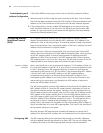
4
NETWORK PROTOCOL OPERATION
This chapter covers the following topics:
■ Configuring IP Address
■ Configuring Address Resolution Protocol (ARP)
■ DHCP Relay
■ IP Performance
Configuring IP
Address
IP address is a 32-bit address represented by four octets. IP addresses are divided
into five classes, A, B, C, D and E. The octets are set according to the first few bits
of the first octet.
The rule for IP address classification is described as follows:
■ Class A addresses are identified with the first bit of the first octet being 0.
■ Class B addresses are identified with the first bits of the first octet being 10.
■ Class C addresses are identified with the first bits of the first octet being 110.
■ Class D addresses are identified with the first bits of the first octet being 1110.
■ Class E addresses are identified with the first bits of the first octet being 11110.
Addresses of Classes A, B and C are unicast addresses. The Class D addresses are
multicast addresses and Class E addresses are reserved for future uses.
At present, IP addresses are mostly Class A, Class B and Class C. IP addresses of
Classes A, B and C are composed of two parts, network ID and host ID. Their
network ID lengths are different.
■ Class A IP addresses use only the first octet to indicate the network ID.
■ Class B IP addresses use the first two octets to indicate the network ID.
■ Class C IP addresses use the first three octets to indicate the network ID.
At most, there are: 28 =128 Class A addresses, 216=16384 Class B addresses and
224=2,097,152 Class C addresses.
The IP address is in dotted decimal format. Each IP address contains 4 integers in
dotted decimal notation. Each integer corresponds to one byte,
e.g.,10.110.50.101.
Configuring an IP Address is described in the following sections:
■ Subnet and Mask
■ Configuring an IP Address


















